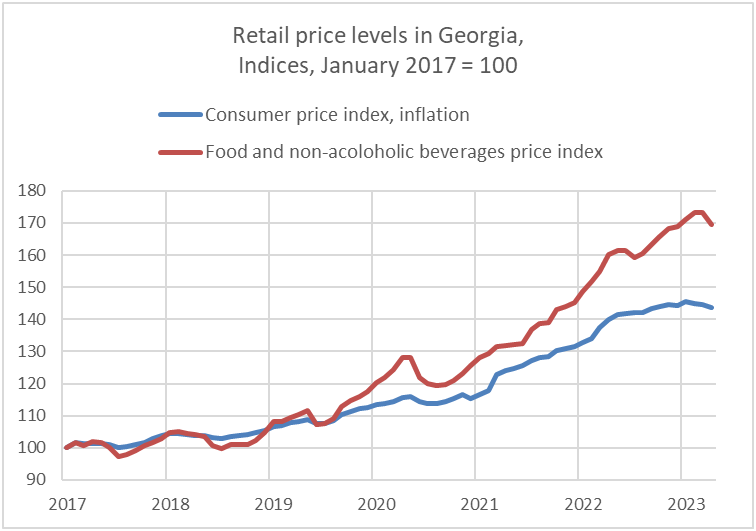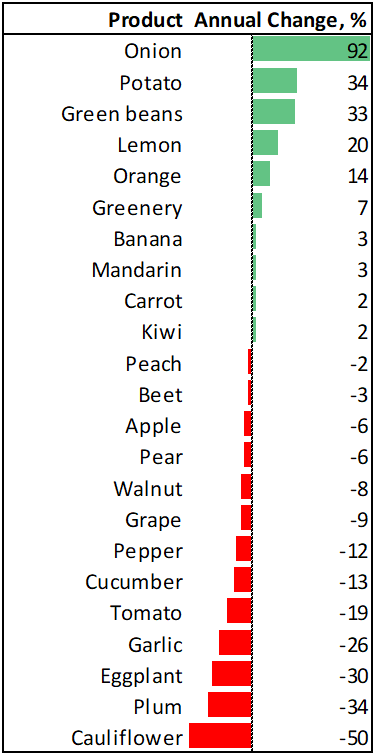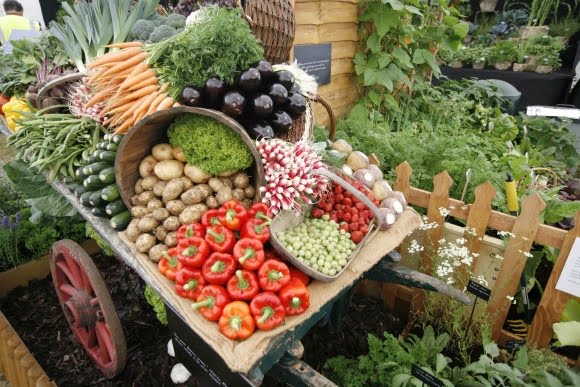EastFruit analysts review the latest retail price dynamics in Georgia. According to official statistics, retail prices for vegetables in Georgia went down by 6% in April 2023 compared to March 2023. Further reduction is expected in May.
 Data source: GeoStat
Data source: GeoStat
Vegetable prices follow a more general trend. The average price for all goods and services, not just food or vegetables, reduced by 1% month-over-month. Retail price for the food group was reduced by 2%. Such dynamics are of a seasonal nature – price levels tend to reduce every year at this time of the year.
Specifically for vegetables, the mentioned price reduction is associated with the increased supply on the market. Part of this increase comes from the local producers, mostly tomato and cucumber producers, who produce in high tunnels. Imports from the neighboring countries also play a significant role in boosting supply in the Georgian market. These products also come from high tunnels and greenhouses. Their costs of production around April are of course lower than the costs in winter. Hence, there is a downward pressure on the prices.
Generally, March, April, and May are the most active months for Georgia’s fruit and vegetable imports. Local supply is weak and there is a large window of opportunity.
Some major factors also affected the Georgian market. According to the monthly review of the National Bank of Georgia, prices for goods, and international transportation costs have reduced globally. As Georgia depends on imports a lot, these two factors surely played a role in the reduction of prices in general, and the reduction of vegetable prices specifically.
The strengthening of Georgia’s currency is also important. Holding all else equal, when local currency gains value it can afford more imported products with the same amount – imports become cheaper. Value of the US Dollar against the Georgian Lari reduced by 3% in April 2023 compared to March 2023.
Seasonal price reduction is not a one-month event. Supply from both local and foreign producers usually increases further in May. Also, open-field produce slowly starts to enter the market.
Comparing April 2023 to April 2022, the change in the general price level, or inflation, is 2.7% – which is below Georgia’s target of 3%. The latter was mostly driven by the reduction in fuel and medicine prices. Retail price for the food group is up by 6%, vegetable prices specifically are up by on average 11%. Interestingly, year-on-year vegetable price growth in March 2023 stood at 29%! So, even if the 11% can seem high, the gap between 2023 and 2022 is closing. The annual devaluation of the US Dollar against the Lari amounts to 18%, which should be quite helpful for importers.
Interestingly, the annual retail price growth for vegetables (which also includes potatoes in this context) comes from only two products.

Data source: GeoStat
The statistics office of Georgia publishes retail price changes for 23 positions of fruits, nuts, and vegetables. Here we can see the high annual price growth of the vegetable group mentioned above (+11% compared to April 2022) is solely driven by onions and potatoes. These two products have become extremely expensive in the 2022/2023 season given the supply shortages covered numerous times by EastFruit.
Considering the very high inflation rates of more than 10% in Georgia in earlier months, the current outlook from the National Bank of Georgia can be good news. The bank does not expect large growth after the seasonal reduction blows over. Annual general price growth, or inflation at the end of the year is expected to stand at 3.6%.
As for the vegetables, we have seen above that the gap between 2022 and 2023 prices is reducing for the group. Most vegetables are cheaper than they were year before. Potatoes and onions are very expensive, and they drive up the average price for the group. Their harvest in Georgia will very likely result into significantly reduced prices. Market supply of onions and potatoes from the upcoming harvest usually peaks in June.
The use of the site materials is free if there is a direct and open for search engines hyperlink to a specific publication of the East-Fruit.com website.




